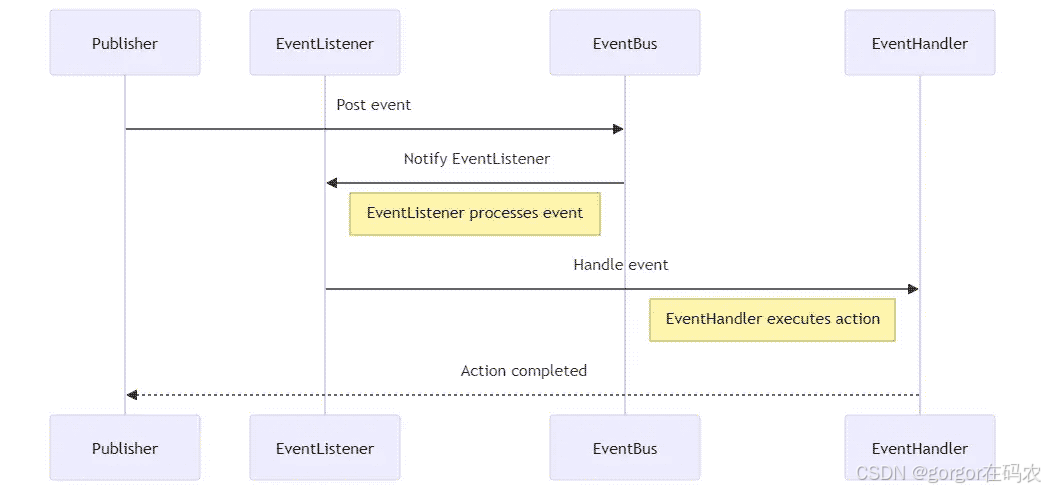Google Guava 发布订阅模式/生产消费者模式 使用详情
目录
Guava 介绍
Guava 是一组来自 Google 的核心 Java 库,里面包括新的集合 类型(例如 Multimap 和 MultiSet),不可变集合、图形库、 以及用于并发、I/O、哈希、基元、字符串,发布/订阅模式等等。接下来主要讲解 发布订阅模式。
Guava 发布订阅主要包含以下主要核心部分:
- Event 事件
- Publisher 事件发布者
- EventListener 事件订阅者
- EventBus 事件总线
工作流程:
Publisher 事件发布者 通过 EventBus 事件总线 发布事件,然后 EventBus 事件总线 把事件传给 Subscriber 事件订阅者 消费。
工作原理图:

应用场景举例
当用户注册App后,可能会产生很多行为,比如需要发短信提醒用户,注册成功,获取100积分,又或者需要给注册成功的用户送优惠卷。如果按我们平时的写法,则需要在用户注册成功后,返回请求前,需要引入发短信和发优惠卷的逻辑,不仅使冗余在注册代码中,造成耦合度太高。职责不分离。
这时就可以引入Guava 的发布订阅模式。让发送短信的监听器 和 发优惠卷的监听器 同时监听同一个事件即可。
1. 引入 Maven 依赖
<?xml version="1.0" encoding="UTF-8"?>
<project xmlns="http://maven.apache.org/POM/4.0.0" xmlns:xsi="http://www.w3.org/2001/XMLSchema-instance"
xsi:schemaLocation="http://maven.apache.org/POM/4.0.0 https://maven.apache.org/xsd/maven-4.0.0.xsd">
<modelVersion>4.0.0</modelVersion>
<parent>
<groupId>org.springframework.boot</groupId>
<artifactId>spring-boot-starter-parent</artifactId>
<version>2.2.1.RELEASE</version>
</parent>
<groupId>com.xinxin</groupId>
<artifactId>cyh</artifactId>
<version>0.0.1-SNAPSHOT</version>
<properties>
<java.version>1.8</java.version>
</properties>
<dependencies>
<dependency>
<groupId>org.springframework.boot</groupId>
<artifactId>spring-boot-starter-web</artifactId>
</dependency>
<dependency>
<groupId>org.projectlombok</groupId>
<artifactId>lombok</artifactId>
</dependency>
<dependency>
<groupId>com.google.guava</groupId>
<artifactId>guava</artifactId>
<version>19.0</version>
</dependency>
<dependency>
<groupId>com.alibaba</groupId>
<artifactId>fastjson</artifactId>
<version>1.2.70</version>
</dependency>
</dependencies>
</project>
2. 自定义 Event 事件类
Event 类是我们生产者和消费者 消息传播的载体,也就是发送的内容,通常我们以 Event 为后缀来命名事件类。
import lombok.AllArgsConstructor;
import lombok.Data;
import lombok.NoArgsConstructor;
import java.util.Date;
/**
* @description: 用户注册事件
* @author: cyh
* @create: 2024-11-02 17:07
**/
@AllArgsConstructor
@NoArgsConstructor
@Data
public class UserRegisterEvent {
private Long userId;
private Date registerTime;
}
3. 定义 EventListener 事件订阅者
事件订阅者即事件的监听者,接受事件消费的一端。监听者会一直监听他们所关注的事件。
事件订阅者的定义,需要在方法上添加@Subscribe注解声明自己为事件订阅者,然后方法参数是他们监控的 Event 事件。
一般@Subscribe可以配合@AllowConcurrentEvents注解一起使用,这个注解是用来标识当前订阅者是线程安全的,可以减少同步开销。
3.1 定义 发送短信 事件订阅者
/**
* @description: 短信事件监听器
* @author: cyh
* @create: 2024-11-02 17:10
**/
@Slf4j
@Component
public class SmsEventListener {
@Subscribe
@AllowConcurrentEvents
public void recordRegisterLog(UserRegisterEvent event) {
Long userId = event.getUserId();
Date registerTime = event.getRegisterTime();
log.info("短信监听器 监听到用户注册行为,用户 {} 在 {} 注册成功,事件内容为:{}", userId, registerTime, JSON.toJSONString(event));
//发送短信通知
log.info("发送短信通知");
}
}3.2 定义 发送优惠卷 事件订阅者
/**
* @description: 优惠卷事件监听器
* @author: cyh
* @create: 2024-11-02 17:10
**/
@Slf4j
@Component
public class CouponEventListener {
@Subscribe
@AllowConcurrentEvents
public void recordRegisterLog(UserRegisterEvent event) {
Long userId = event.getUserId();
Date registerTime = event.getRegisterTime();
log.info("优惠卷监听器 监听到用户注册行为,用户 {} 在 {} 注册成功,事件内容为:{}", userId, registerTime, JSON.toJSONString(event));
//发送优惠卷
log.info("发送优惠卷");
}
}4. 定义 EventBus 事件总线
EventBus 事件总线的作用是,将 Event 事件 转发给 EventListener 事件订阅者。所以 首先我们就要把 事件订阅者注册给总线,它才知道有哪些订阅者需要转发。 然后将不同的 Event 事件 转发给订阅了该事件的订阅者。
事件总线有两个作用:
- 发布消息
- 转发消息给订阅者
4.1 EventBus 事件总线,代码定义
/**
* @description: 事件总线
* @author: cyh
* @create: 2024-11-02 17:16
**/
@Slf4j
@Component
public class EventBusCenter {
private static EventBus eventBus;
private static AsyncEventBus asyncEventBus;
private static Executor executor = new ThreadPoolExecutor(12, 12, 60,
TimeUnit.SECONDS, new LinkedBlockingQueue<Runnable>(100000), Executors.defaultThreadFactory(), new ThreadPoolExecutor.CallerRunsPolicy());
/**
* 异步事件单例模式
* @return
*/
private static synchronized AsyncEventBus getAsyncEventBus() {
if(asyncEventBus == null){
asyncEventBus = new AsyncEventBus(executor);
}
return asyncEventBus;
}
/**
* 同步事件单例模式
* @return
*/
private static synchronized EventBus getEventBus() {
if(eventBus == null) {
eventBus = new EventBus();
}
return eventBus;
}
public static void register(Object object) {
getEventBus().register(object);
getAsyncEventBus().register(object);
}
public static void unregister(Object object) {
getEventBus().unregister(object);
getAsyncEventBus().unregister(object);
}
/**
* 同步发送事件
* @param event
*/
public static void post(Object event) {
log.info("同步发送事件内容:{}", JSON.toJSONString(event));
eventBus.post(event);
}
/**
* 异步发送事件
* @param event
*/
public static void asyncPost(Object event) {
log.info("异步发送事件内容:{}", JSON.toJSONString(event));
asyncEventBus.post(event);
}
}
4.2 将 EventListener 事件订阅者注册到总线中
@Order(1)
@Slf4j
@Component
@Configuration
public class RegisterListenerToBus implements ApplicationListener<ApplicationReadyEvent> {
@Resource
private SmsEventListener smsEventListener;
@Resource
private CouponEventListener couponEventListener;
@Override
public void onApplicationEvent(ApplicationReadyEvent event) {
log.info("ApplicationReadyEvent init restTemplate.");
try {
//监听器注册
EventBusCenter.register(smsEventListener);
EventBusCenter.register(couponEventListener);
} catch (Exception e) {
log.error("初始化配置失败!", e);
}
log.info("ApplicationReadyEvent init restTemplates finished.");
}
}5. 定义 Controller 进行测试
/**
* @description:
* @author: cyh
* @create: 2024-11-02 17:28
**/
@RestController
public class RegisterController {
@GetMapping("/register")
public String register(Long userId){
UserRegisterEvent event = new UserRegisterEvent(userId, new Date());
//同步发送
EventBusCenter.post(event);
// //异步发送
// EventBusCenter.asyncPost(event);
return "ok";
}
}测试结果
同步发送事件内容:{"registerTime":1730557363231,"userId":1594}
短信监听器 监听到用户注册行为,用户 1594 在 Sat Nov 02 22:22:43 CST 2024 注册成功,事件内容为:{"registerTime":1730557363231,"userId":1594}
发送短信通知
优惠卷监听器 监听到用户注册行为,用户 1594 在 Sat Nov 02 22:22:43 CST 2024 注册成功,事件内容为:{"registerTime":1730557363231,"userId":1594}
发送优惠卷原文地址:https://blog.csdn.net/weixin_46203834/article/details/143454015
免责声明:本站文章内容转载自网络资源,如本站内容侵犯了原著者的合法权益,可联系本站删除。更多内容请关注自学内容网(zxcms.com)!
